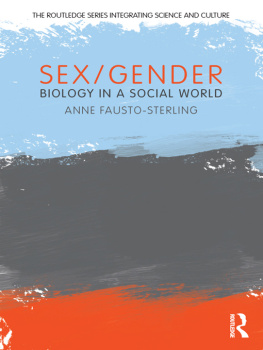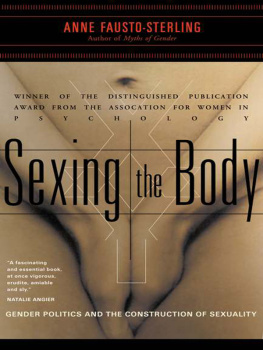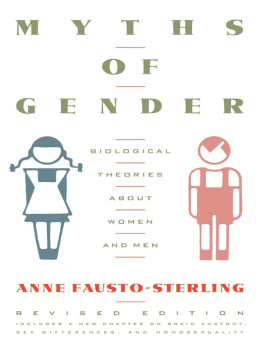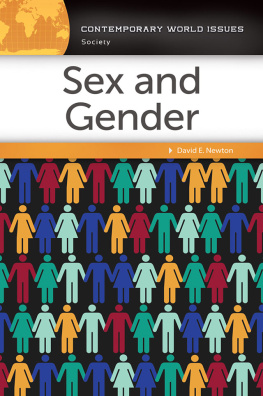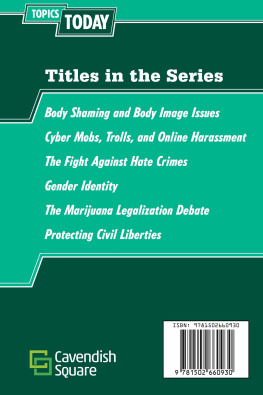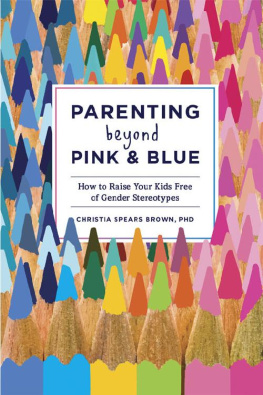ACKNOWLEDGMENTS
From Anne Fausto-Sterling, Sexing the Body: Gender Politics and the Construction of Sexuality . Copyright 2000 by Anne Fausto-Sterling. Reprinted with the permission of Basic Books, Inc., a member of Perseus Books Group.
Adapted from J. Money and A. A. Ehrhardt, Man and Woman, Boy and Girl (Baltimore: The Johns Hopkins University Press, 1972), p. 3. Copyright 1972. Adapted with permission.
From JeongMee Yoon, The Pink and Blue Project (2006). Reprinted with permission of the artist.
Adapted from C. M. Shoemaker and D. Crews, Analyzing the coordinated gene network underlying temperature-dependent sex determination in reptiles from Seminars in Cell and Developmental Biology , 20(3): 296, Figure 1. Reprinted with the permission of Elsevier Science Limited.
. Copyright 2010. Reprinted with the permission of Sinauer Associates, Inc., Publishers.
From Keith L. Moore and T. V. N. Persaud, The Developing Human: Clinically Oriented Embryology, Eighth Edition , page 272, Figure 12.37. Copyright 2008 by Saunders, an imprint of Elsevier, Inc. Reprinted with the permission of Elsevier Science Limited.
From N. Wade, Tug of War Pits Genes of Parents in the Fetus from The New York Times (September 13, 2010): Section D, p. 5. Copyright 2010 by The New York Times Company. All rights reserved. Used by permission. The printing, copying, redistribution, or retransmission of the Material without express written permission is prohibited.
From M. M. McCarthy and A. T. Konkle, When is a sex difference not a sex difference? from Frontiers in Neuroendocrinology , 26(2): 87, Figure 1. Copyright 2005 by Elsevier. Reprinted with permission.
(a)Neonate fusiform gyrus:
From J. LeRoy Conel, The Postnatal Development of the Human Cerebral Cortex (Harvard University Press, 1939). Figure 135.
(b)Three-month fusiform gyrus:
From J. LeRoy Conel, The Postnatal Development of the Human Cerebral Cortex (Harvard University Press, 1947). Figure 147.
(c)Six-month fusiform gyrus:
From J. LeRoy Conel, The Postnatal Development of the Human Cerebral Cortex (Harvard University Press, 1951). Figure 147.
(d)Fifteen-month fusiform gyrus:
From J. LeRoy Conel, The Postnatal Development of the Human Cerebral Cortex (Harvard University Press, 1955). Figure 147.
From M. Hines, S. F. Ahmed, and I. A. Hughes, Psychological Outcomes and Gender-Related Development in Complete Androgen Insensitivity Syndrome from Archives of Sexual Behavior , 32(2): 99100, Appendix A. Copyright 2003 by Springer Netherlands. Reprinted with the permission of Springer.
After Rust, J., Golombok, S., Hines, M., Johnston, K., & Golding, J. (2000). The role of brothers and sisters in the gender development of preschool children. Journal of Experimental Child Psychology , 77(4), 292303.
Geoffrey Warren, excerpt from Fashion Accessories since 1500 . Copyright 1987 by Geoffrey Warren. Reprinted with the permission of HarperCollins Publishers, Ltd.
, 6.5, 6.7 Reprinted by permission of the publisher from Brain Storm: The Flaws in the Science of Sex Differences by Rebecca M. Jordan-Young, pp. 130, 141, 168, Cambridge, MA: Harvard University Press. Copyright 2010 by the President and Fellows of Harvard College.
From E. O. Laumann, J. H. Gagnon, R. T. Michael and S. Michaels, The Social Organization of Sexuality: Sexual Practices in the United States . Copyright 1994 by Edward O. Laumann, Robert T. Michael, CSG Enterprises, Inc., and Stuart Michaels. Reprinted with the permission of The University of Chicago Press.
From J. S. Hyde, New Directions in the Study of Gender Similarities and Differences from Current Directions in Psychological Science , 16 (2007): 260, Table 1. Copyright 2007 by the Association for Psychological Science. Reprinted with the permission of Sage Publications, Inc.
From R. Lewontin, Human Diversity , p. 21. Copyright 1982. Reprinted with the permission of W. H. Freeman and Company.
From C. D. Schlichting and M. Pigliucci, Phenotypic Evolution: A Reaction Norm Perspective , p. 56, Figure 35. Copyright 1998. Reprinted with the permission of Sinauer Associates, Inc., Publishers.
1
A GENDERLESS FUTURE?
What were they thinking! In March, 2010 the New South Wales (Australia) Registry of Births, Deaths and Marriages sent Scottish-born Norrie May-Welby an immigration certificate listing her as sex not specified. The bureaucratic decision to allow May-Welby to immigrate without specifying his/her sex or gender came after an extended legal battle. As it turned out, May-Welbys official genderlessness was a way station in a struggle that continues as of this writing. Following intense publicity, the Registry backtracked, claiming it did not have legal authority to produce a gender neutral certificate. May-Welby is suing. Moreover, May-Welby is not the only person on earth who wishes to live gender free. Reporters Barbara Kantrowitz and Pat Wingert suggest that a growing number of people consider themselves gender neutral (Kantrowitz & Wingert, 2010).
Confusion about gender categories (Male? Female? Neither? Both?) seems to be perennially newsworthy. Take the case of the South African runner Caster Semenya. During the summer of 2009, she beat the womens 800-meter running record by several seconds. Although her achievement remained a good 18 seconds off the mens record, her breakthrough prompted complaints that Ms. Semenya was really a man. An international scandal erupted when the International Association of Athletics Federations (IAAF), track and fields governing body, barred her from competition until she completed a gender test.
A what? What on earth is a gender test? You might think it is simple to tell who is male and who is female. Indeed, sometimes it is simple. But not always. More than a year into this story the IAAF decided to allow Semenya to resume competition. In August of 2010 she won handily in womens races in Berlin, Germany and in June 2011 she came in third in competition in Oslo, Norway (Bolt Blitz in Oslo; Athletics, 2011). But the IAAF did not release the gender test results, rightly maintaining that these contain Caster Semenyas personal and very private health information. So we remain in the dark about what a gender test actually is and how, in this case, it gave the IAAF the information it needed to allow Semenya to resume competition (Caster Semenya, 2010).
Genderless Australian immigrants. Record breaking runners who may not really be women. What then, are we to think about the future of gender? Is it really disappearing (I doubt it); should there be more than two legal gender categories (possibly); do we know enough about sex and gender to deal intelligently with the idea of a genderless future (no)? After all, dont chromosomes that join together at fertilization fix sex and gender for a lifetime (no)? Dont societies all think (more or less) the same way about sex and gender (no)? Have they always thought the same way about sex and gender (and no again)? Perhaps there are things about sex and gender that we can never know. And if so why cant we know them? These are among the questions this book addresses. Perhaps you thought you already knew what sex was, what gender was, and all of the essentials about human sexuality. And perhaps so. But in this book I start at the beginning with developing embryos and explore what we know about sex and gender and how well we know it. Then, based on the knowledge gained, maybe we can look at the future of gender, if not definitively, perhaps and at least, intelligently.
2
OF SPIRALS AND LAYERS

